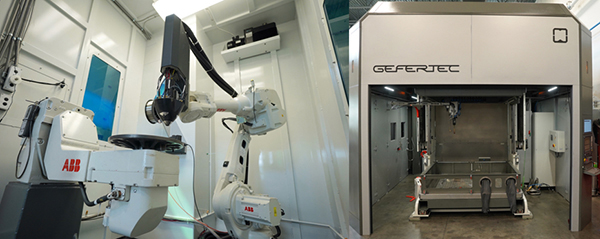As additive manufacturing processes and materials evolve, manufacturing leaders should take a strategic approach to implementation.
The last decade has been marked by rapid growth in the additive manufacturing (AM) industry. As 3D printing equipment has become increasingly accessible and applications have become more diverse, the utilization of the technology has risen.
A recent study by EY found that 65% of companies surveyed were applying AM to some degree, up from 24% in 2016. However, while a record number of organizations are experimenting with 3D printing, many manufacturing leaders are still unsure how best to employ the technology.
AM offers a range of benefits when compared with traditional manufacturing techniques. The first is reducing material waste. Subtractive methods like turning and milling hinge on removing material to create a finished product, while the casting process relies on the production of molds. In contrast, the additive process builds up deposits layer by layer. This can create significantly less waste, enabling manufacturers to preserve resources and energy.
In addition, additive technologies allow manufacturers to produce parts on demand, eliminating the need to store large amounts of inventory. 3D printing can often occur closer to the point of use, too, localizing production. This cuts lead times and expenses associated with shipping parts. It can also limit the impact of supply chain disruptions, such as those seen during the pandemic.
In some cases, localized production can even save lives. The Mayo Clinic has used in-house 3D printing devices to fabricate surgical aids that support complex medical procedures, including removing tumors and performing facial reconstruction surgery. Meanwhile, the Hospital for Special Surgery (HSS) in New York recently reported using on-site printers to produce custom-made joint replacements for patients.
After decades of innovation, AM is no longer an experimental discipline. Awareness of the technology is rising, and many manufacturers are eager to capitalize on its potential. However, before investing in the technology, companies should ensure that they build a comprehensive implementation plan. Here are five steps leadership teams can take to enable their organizations to successfully integrate AM into their existing ecosystems:
Research Methods and Materials
Before manufacturing leaders can adopt AM, they need to understand the applications, machines, methods, and materials available to them. Attending trade shows, researching hardware and software, and talking to product representatives can help manufacturers visualize how the technology might fit into their operations.
Identify Relevant Use Cases
Once manufacturers have a clear idea of what industrial 3D printing can accomplish, they should audit their operations to identify scenarios where AM can streamline processes and improve outcomes. It may be helpful to introduce 3D printing tools gradually. For instance, designers could start by using AM for rapid prototyping. When they have mastered the technology for this purpose, their organization could expand its use to other production phases.
Bring in the Right Partners
Integrating industrial 3D printing into a manufacturing ecosystem takes time, money, and knowledge. But manufacturing leaders don’t have to make the leap alone. By partnering with an AM service bureau, companies can take advantage of specialized expertise and equipment at a fraction of the cost that bringing the technology in-house would entail. This allows manufacturing firms to test and refine their processes, staying agile as the landscape evolves.

Invest in Education
Hardware and software are not the only investments manufacturers must make to harness AM’s considerable capabilities. Workforce development is equally — if not more — important. Fortunately, there are a growing number of AM training programs available. These support employees in acquiring the skills necessary to maximize the benefits of additive technologies.
Embrace Continuous Improvement
From prototyping to end-use parts and polymers to biomaterials, AM has come a long way since early use cases in the 1980s. Manufacturers are discovering new ways to leverage the technology with every new application, material, and process.
By staying abreast of these developments, companies can ensure they remain adaptive and competitive. Publications, research studies, and industry conferences are all excellent ways to stay informed about the latest advancements in AM.
Industrial 3D printing is gaining momentum, and it is increasingly a question of when, not if, more organizations will adopt the technology. With the help of AM, manufacturers can streamline processes, condense lead times, and reduce material and energy costs — all while uncovering new opportunities for innovation.
However, to implement additive technologies effectively, leadership teams must take a strategic approach. This should include extensive research, a thorough assessment of operations, and an ongoing investment in education. By fostering a culture of continuous learning and improvement, manufacturing leaders can set their companies up to grow alongside the technology, laying the foundation for long-term success.

About the Author:
Yash Bandari, Ph.D., is the director of business development at FasTech LLC. He is an internationally recognized manufacturing professional with more than 12 years of experience in metal 3D printing, especially in directed energy deposition (DED) processes. Bandari specializes in business development and the commercialization of new products. He is an event advisor for RAPID + TCT 2024.
In this episode, I sat down with Beejan Giga, Director | Partner and Caleb Emerson, Senior Results Manager at Carpedia International. We discussed the insights behind their recent Industry Today article, “Thinking Three Moves Ahead” and together we explored how manufacturers can plan more strategically, align with their suppliers, and build the operational discipline needed to support intentional, sustainable growth. It was a conversation packed with practical perspectives on navigating a fast-changing industry landscape.